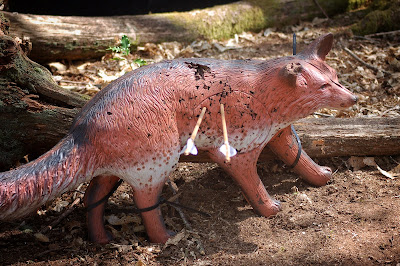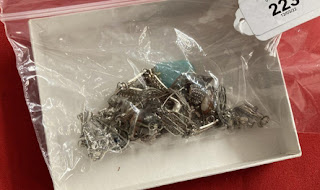Mike Bodnar highlights why some media science is just astronomically wrong...
As you can see from the headline of my opening image, someone has captured brilliant photos of Comet Leonard 'streaking' through the night sky. And sure, it really does look like it's hurtling through space, what with that long elegant tail streaming out and all.
But I have to disabuse you of something: comets don't streak, at least not in our skies. They move infinitesimally, incrementally, night after night. (Unless, of course, you're watching Don't Look Up, in which case it's time to kiss your ass goodbye)
Sure, up in space they really are hurtling; Leonard's a fast kinda guy - barrelling along at an estimated 158,084 miles per hour (254,412 km/h or 70.67 km/second), but due to the vast distance between us and Len, we don't see that speed here on Earth.
Imagine you're in an aircraft at 35,000 feet looking down on a desert highway below. You can see a vehicle. It doesn't appear to be moving, well maybe not much. But now imagine you're a hitch-hiker standing on the side of that same road. The car approaches and suddenly zooms past you, doing, let's say, 90 miles per hour. Whoa, that's fast! It just blew the cardboard hitch-hiking sign out of your hand! And they didn't stop!
Unfortunately, the media tends to use words like 'streak,' 'zoom,' and 'shoot' when referring to comets, which - for those who've perhaps never seen a comet before - raises expectations of some sort of spectacle where the celestial object is going to put on a display you'd expect to see at a fireworks event.
Don't get me wrong - comets can definitely be spectacular, but we've had only nine significant comets - that is, comets visible to the naked eye during daytime - in the past 300 years or so.
 |
| Comet McNaught. Image: Mike Bodnar |
One of the more recent was Comet McNaught, named after the Australian astronomer who discovered it, and which could be seen in 2007. Visible mainly from the southern hemisphere, some reported they saw it in daylight, but from where I was at the time - in Wellington, New Zealand - it required a keen eye and a dark sky without light pollution just after sunset to see it at all. But I did, just - see the pic and play Spot the Comet.
Which brings us to one of astronomy's biggest enemies: light pollution. Too many journalists rave that a comet 'can be seen' in a particular part of the sky without mentioning that if you live in a city you're unlikely to see anything at all due to light pollution. Some comets are so faint you need truly dark skies, such as those in Northumbria, a designated 'dark sky area,' to see anything.
And before we leave comets, may I just touch on the tail? A comet's tail develops more as it gets closer to the sun, due to the sun's influence on the actual comet which is an icy ball of rock and dust. The tail doesn't so much streak behind the comet as demonstrate which way it's oriented. That is, the tail will always face away from the sun regardless of the comet's direction of travel, because the ice and dust being burned off streams out away from it. So it's not, for example, the same as a boat's wake in the water, which will always be behind the boat and away from the boat's direction of travel.
 |
| No. Just no. |
So even when a comet has passed the sun it's tail will still point away from it. Therefore, not only is a comet's tail nothing to do with its streaking, hurtling speed, it means you will likely best see a comet either just after sunset or just before sunrise. Unless of course it's one of those once-in-a-lifetime big buggers.Now let's come to meteors. More specifically of course, meteors come to us, but once again the media rave about meteor showers putting on a 'spectacular display,' or that they will be 'stunning.'
Before we get into why some of that hype is only partially true, let's look at the media image here, which announces that a 'stunning' meteor shower is to take place over the UK.
Firstly, the image the tabloid has used does not show meteors; it shows star trails captured in a time lapse by a camera. Never will you see this with the naked eye because we as humans don't have the ability to slow down time and observe it thus.
Don't get me wrong - it's a lovely picture, but the picture editor has been lazy and chosen something that they think looks 'stunning,' and, in their ignorance, they have once again skewed readers' expectations of what they might see.
 |
| A meteor caught on camera. Image: iNews |
Meteors are basically bits of space rock that burn up as they enter Earth's atmosphere. Unlike comets they really do streak, sometimes so fast that if you blink you'll miss them. There are two main categories of meteors (sometimes called shooting stars): we have random meteors, which arrive unexpectedly and take us by surprise, and meteor showers, which are predictable.
Meteor showers are predictable because Earth's orbit, which is also predictable, passes through various known fields of rocky space debris as it goes around the sun, but the term 'showers' itself raises expectations.
A really good meteor shower could mean that, in a nice dark sky location with no clouds, you might see on average 50 meteors an hour, obviously an average of just under one per minute. But you're most unlikely to see a whole heap of them burn up in the atmosphere at the same time like fireworks.
Seeing 50 in an hour is, in astronomy-speak, truly stunning, but to the everyday non-astronomical bystander it's almost yawn territory, and in this day and age of short attention spans, many people want spectacular or stunning to mean that they can look at the sky for five minutes with a glass of Sancerre in their hands and be amazed at the spectacle above them.
So when the media rants about how spectacular a meteor display will be, take it with a grain of salt. Also check the weather forecast, make sure you're prepared to travel to a dark sky location, and take a comfortable folding chair, a flask of coffee, warm clothing, and lots of patience. Look up and enjoy.
 |
The spectacular Arizona Crater formed by a large meteor impact.
Remains of the meteorite can be seen in the crater's information centre. Image: Mike Bodnar |
Before we leave meteors, a couple of clarifications. Firstly, when people talk about having had a meteoric rise in their careers, they're meaning it was fast. Meteors don't rise - they only fall. Secondly, when a meteor burns up completely in the atmosphere it remains a meteor. If parts of it fall to earth then they become meteorites. Just saying.
Asteroids meanwhile are rocks in space. They're a bit like comets except with little or no ice and less dust. They're the stuff of disaster movies, and famously one has been found guilty of wiping out the dinosaurs and a large portion of other life on Earth when it entered our atmosphere and struck the planet 65 million years ago.
 |
| We're all going to f***ing die! |
Advances in astronomy and detection technology in recent years mean that we now know of many many asteroids, and scientists maintain vigil over their orbits and paths, especially in relation to Earth. Most pose no threat whatsoever, but in recent years the media has thrilled to the concept of an asteroid having a close encounter with Earth, using phrases such as, 'Near Miss,' Brush with Extinction,' and, last November, 'Concerning asteroid will break into Earth's orbit in a week.' Quick, duck!!!The story originated in a tabloid and was quickly picked up by other organs for its shock-horror value. The accompanying video began with, 'A giant asteroid is heading towards Earth.' Well, if you were just a headline reader you'd be running screaming for the hills, or walking through a park a la Jennifer Lawrence in Don't Look Up telling everyone, 'You're all going to f***ing die!'
You have to read further into the article to learn that not only was the asteroid not heading for Earth, it would be about 10 times as far away as the moon at its closest approach and poses no threat whatsoever. But a headline that says, 'No Threat Posed By Asteroid' doesn't grab readers. Or terrify them. Or sell newspapers.
 |
Oh dear.
Image: Getty Images, as used by the NY Post |
And note that the headline says the rock would '...break into Earth's orbit.' Forgive me, but many people would read that and assume it meant Earth's atmosphere, which, if it were true, certainly would require Jennifer Lawrence to comment. A good analogy would be: you're in your car and you join the M25 ring road around London at a point in the south. At the same time a petrol tanker crosses the same motorway in the north on an overpass. You are, if you like, briefly on the same orbit around London, but the chances of you crashing into that tanker and dying horribly in a roaring inferno are pretty much zero.
In short, you are more likely to suffer ill health and mental issues reading tabloid hype than you are of dying in an extinction event caused by an asteroid.
Finally, let's turn our metaphorical telescopes to the moon and the hype that's been promulgated by the media about our nearest celestial neighbour.
I'm not talking about NASA's or billionaires' plans to send people there or build lunar colonies; I'm talking about the hype surrounding all the different names given to the full moon every time one comes around, which is approximately monthly.
 |
Lunar eclipse, or Blood Moon.
Image: Mike Bodnar |
You've heard them: there's the wolf moon, the blue moon, the blood moon, the pink moon and
so on. Bollocks. In the end, the only one that will look any different would be a 'blood' moon, which actually just refers to the red colour it turns during a full lunar eclipse when the Earth's shadow passes across it, which is a rare event. All the others are names drawn from myth and legend, or, like the harvest moon, the seasons. The full moon, for the most part, whatever it's named, will just look like it always does.That said, never pass up an opportunity to look at the moon and marvel at our nearest neighbour. Use binoculars to see craters, and the so-called 'seas,' or use a telescope for even more detail. Avoid doing this during a full moon because the whole surface is lit up uniformly by the sun; far better to view it when it's a crescent, or a half moon, when you can marvel at the craters in relief along the sunlit edge.
So, my advice about all things celestial is: don't believe all the media hype, but do always look up when you get the chance. Marvel at the night sky, not at the media headlines.







































